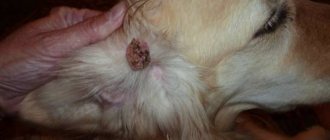What should the nose be like?
The dog's nose should be cold and wet, and the discharge, if any, should be insignificant and transparent, and not cloudy and especially not purulent. The skin on the nose should not be covered with scabs or crusts and should not crack. If your dog's nose is dry and hot, he may be dehydrated and need a drink.
For prevention purposes, you can lubricate your nose with ointment with calendula extract or aloe juice, after wiping it with a damp swab.
And when a dog is sick, what kind of nose might it have?
IMPORTANT! The color of the nose, as a rule, does not change after the dog finally grows up, but if this happened already in the pet’s adulthood and his nose changed color or pigmented or, on the contrary, discolored spots appeared on it, this is a reason to contact a veterinarian.
How can you tell if your dog is sick?
Most dog diseases can be cured much easier if you notice them at an early stage. But animals cannot tell their owner about their illness, or show what and where it hurts. How to determine that your dog is sick in order to provide timely help to your pet?
The first sign that a dog is sick is most often changes in behavior . The dog becomes lethargic, apathetic, inactive, loses interest in previously favorite games, and is reluctant to go for a walk. Often sick dogs try to hide in a dark, secluded corner, moaning or squealing. They do not respond to nicknames, and if they do respond, they are reluctant to get up. Sometimes the dog, on the contrary, becomes more aggressive and does not even let familiar people near it.
Another sign of illness may be loss of appetite . Although not always: sometimes dogs kept in urban environments may not eat for about a day. This is due to the fact that city dogs are sometimes overfed, and they move little, so in this way the animal simply arranges a voluntary “fasting day”. An abnormally increased appetite , by the way, may also indicate that the dog is sick.
In a sick dog, instead of being smooth and shiny, the coat becomes disheveled and dull, and the animal often loses weight during illness. You can also determine that your dog is sick by looking at his nose. A healthy dog's nose is cold and wet, while a sick dog's nose is dry and hot . But you can’t be guided only by this sign. When a dog sleeps, and also in the first minutes after waking up, its nose may be dry and hot. And at first, after the temperature rises, it sometimes remains cold.
By the way, about temperature. Normally, a dog’s body temperature is higher than that of a person and is 38-38.9°C . If your animal's body temperature is 39.5°C or higher, you should contact a veterinarian as soon as possible, because an increase in temperature may be a sign of an infectious disease.
Dogs' temperature is measured rectally. You can use a regular veterinary medical thermometer for these purposes. It needs to be lubricated with something greasy - oil, Vaseline or cream. Holding the dog in the groin area, you need to carefully insert the tip of the thermometer into the anus. This must be done very carefully and patiently . After 2-3 minutes the thermometer can be taken out.
After the procedure, you must praise and caress the dog. If she does not refuse food and there are no problems with digestion, you can treat the dog with some kind of treat - this way you will reinforce a calm reaction to taking the temperature .
Please note that an elevated temperature does not always mean that the dog is sick. It can increase with fear and excitement, in the heat, after physical activity. So it’s best to measure the temperature of a healthy dog at rest several times and then compare it with this figure.
Two more objective indicators of a dog’s health are pulse and respiratory rate . To change the pulse, you need to place your fingers on the femoral artery of the animal, it is located on the inside of the thigh. Normal pulse is 70-120 beats per minute. In large and calm dogs it may be lower, and in small breed dogs it can be higher, reaching 160 beats per minute. Here, as with temperature, you need to compare it with your dog’s normal resting heart rate.
The breathing rate is determined by the movement of the dog's abdomen, chest, or wings of the nose. The normal rate is 10-30 breaths per minute. Males breathe less frequently than females, and adult dogs breathe less frequently than puppies and young animals. In the heat, during overexcitation and physical exertion, breathing becomes more frequent, but in a healthy dog it quickly recovers.
Signs that your dog is sick may include indigestion, diarrhea, constipation or vomiting . In principle, a minor stomach upset may simply be the result of overfeeding or eating food that is unusual for the dog. So here you need to look at the “scale of the disaster” and the presence of accompanying symptoms. For example, diarrhea with blood can hardly be called a “minor disorder”.
Another sign that the dog is sick may be:
- discharge from the nose, eyes and other organs (transparent mucous or purulent);
- strong thirst;
- dyspnea;
- difficulty swallowing;
- craving for eating inedible objects;
- increased shedding;
- yellowness or cyanosis of the skin and mucous membranes;
- problems with urination, change in urine color;
- unnatural pose.
In general, many of the signs that a dog is sick are the same as those in cats. These symptoms can be observed in a variety of combinations. If there is anything in your dog's appearance or behavior that worries you, it is best to contact a veterinarian as soon as possible. Many animals were saved precisely because the owner noticed in time that his dog was sick and came to the aid of his pet .
Related publications:
Temperature
What body temperature should a healthy, vigorous dog have? The body temperature of a healthy dog depends on its breed and age. The average normal temperature is 38.5°.
Also, body temperature is higher in representatives of small breeds than in large ones. In general, a temperature from 37.5° to 39° is considered normal, although it is desirable that in medium and large breeds of dogs it is still closer to the average values:
- In puppies it is always slightly higher than in adult dogs: from 39° to 39.5;
- In dogs of small breeds – 38.6° – 39.3°, 38.5° – 39° for puppies and adults, respectively;
- Medium sizes – 38.3°–39.1° for puppies, 37.5°–39° for adults;
- For large dogs – 38.2° – 39° and 37.4° – 38.3° for small and adult dogs.
What color are healthy gums?
The color of a dog's gums is related to the breed of the pet: most dogs have pink gums, but there are also breeds for which black, brown or spotted pigmentation is the norm.
Regardless of whether the gums are pigmented or not, they should not be pale, much less bluish, or yellowish , which may indicate liver disease, or red, which indicates their inflammation or dental disease in the animal:
Step-by-step master class: how to brush your dog’s teeth
Your dog has bad breath
A dog's breath is never particularly pleasant, but sometimes a stinky mouth is a sign of a life-threatening problem. Poor dog breath is caused by bacteria that forms plaque on your pet's teeth. But these bacteria can migrate into the nasal passages and sinuses, leading to breathing problems. If they enter the bloodstream, they can cause damage to the liver, kidneys, or heart. Brush your dog's teeth daily and give him treats or toys made specifically for oral hygiene.
Alexey Khotin is the largest player in the Russian financial market. What is the difference between the hmt technique and other diagnostic methods? Winter essential oils
What do the eyes look like?
- A healthy dog’s eyes are clear and shining, without discharge or excessive lacrimation.
- Eyelashes and hair should not touch the surface of the eye or even injure it.
- The conjunctiva is smooth, even pink in color, moderately moist, without signs of purulent discharge, swelling or inflammation.
- The whites of the eyes are without yellowness and without burst blood vessels. The third eyelid should have the appearance of a light pink membrane, and in no case appear swollen or inflamed.
Articles on the topic: All about the mirrors of the soul: cloudy eyes in a dog are the most likely causes of film Briefly about the important: what to do if a dog’s eyes fester? Eye of Sauron: red eyes in a dog - causes and proper treatment at home Dog tears: can dogs cry?
Your dog has gained weight suddenly
If your dog does not have a defined area between the chest and hips, called a “waist,” then this is likely a sign that the dog is overweight. The Association for Pet Obesity Prevention estimates that 54 percent of dogs in the United States are overweight, which puts them at risk of cancer, diabetes and kidney inflammation just like humans. This can reduce the animal's life expectancy by 2-3 years. All dog owners should know about obesity.
You break these laws every day! 8 effective exercises to increase feminine energy The most beautiful women in sports
How to understand that your pet is sick
In principle, all serious deviations from the normal state of the animal should alert its owner, since most likely this means that the pet is sick. But still, we list the most significant signs of unhealthy dogs. How do you know if your dog is sick?
So, here are the symptoms by which you can determine what your dog is sick with:
Diseases of the gastrointestinal tract
- Vomit. You should be especially alert if the dog has vomited repeatedly and the vomit contains mucus, blood, green or grayish particles. Many dogs also experience so-called “hungry” vomiting in the morning. Despite the fact that it is usually caused by physiological reasons, the owner should also show the dog to a doctor if this phenomenon has become permanent.
- Diarrhea. It can happen for no apparent reason, or after a meal, physical activity, or in the morning, on an empty stomach. It is necessary to show the dog to a doctor, especially in cases where the diarrhea has a rotten or sour smell, when it contains mucus, blood, worms, when its color has acquired a greenish or any other shade unusual for normal feces, or when the dog is diarrhea with undigested food.
- Pica. The pet licks the walls or “vacuums” the floor, eats soil, sand, feces, or swallows inedible things.
- Refusal to eat. Complete - when the dog refuses everything, including his favorite treats, or partial - when the dog eats some foods and at the same time flatly refuses others, which he previously ate with pleasure.
Respiratory diseases
How to tell if your dog has this disease:
- There is discharge from the nose, eyes, and possible drooling.
- The dog is coughing, wheezing, and has hoarse breathing.
- The pet sneezes, rubs its nose with its paws, shakes its head, and crusts of dried mucus may appear on it. The skin on your nose may appear dry, discolored, or cracked.
- The dog has difficulty breathing, the mucous membranes of the nose and mouth are swollen, redness, rashes or inflammation are visible on them.
- In long-haired dogs, due to the excessive secretion of saliva, the hair on the face, chin and chest can become wet, look dirty and hang in sloppy “icicles”.
- In some cases, due to a severe respiratory infection, the dog's lymph nodes under the jaw or behind the ears may become enlarged.
Cardiovascular
How to determine if a dog has CVD:
- The dog is breathing heavily, the mucous membranes of its eyelids and lips are bluish.
- The dog gets tired quickly, does not want to play active games, it is difficult for him to carry out commands that require physical activity, for example, running after a thrown object, jumping over a barrier, practicing detention.
- The animal exhibits tachycardia or arrhythmia.
IMPORTANT! Heart diseases are more common in older dogs, as well as in giant breed dogs, brachycephalics and raw dogs, although they can also be congenital - in this case, young dogs and even puppies suffer from them. Heart diseases can also manifest themselves as complications after serious illnesses or serious injuries.
Musculoskeletal system
- Changed or unsteady gait.
- Stiff or overly cautious movements, when the dog seems to be calculating where to place each of its paws.
- Refusal to exercise and reluctance to climb slopes or stairs.
- The dog experiences obvious pain when bending one or another limb.
- Thickenings have formed at the bends of the joints.
If your pet has a stiff gait, this may indicate not only problems with joints or bones, but also other diseases that cause severe pain, such as colitis, enteritis, kidney disease, poisoning or injury .
Reproductive system
- The bitch’s discharge has become too frequent or, conversely, too rare, and its quantity has also changed (up or down), color, consistency, smell, and foreign inclusions have appeared.
- The external genitalia look inflamed, swelling is noticeable (if we are not talking about bitches during the hunting season - for them, swelling of the loop is the norm), and a rash.
- The dog constantly licks, chews or scratches the affected areas.
- Despite numerous attempts to breed a bitch, she still does not bear offspring.
- Lumps or lumps can be felt in the mammary glands, sometimes there are several of them and they can even be located in whole ridges.
- In male dogs, inflammatory diseases are mainly encountered, in which discharge is observed from the external genitalia of the dog.
Skin diseases
- Redness, inflammation on the skin.
- Pustules or rash.
- Scratches, wounds and scratches.
- Hair loss up to complete or partial baldness.
- Untimely shedding.
- Change in skin color. You should be especially wary if your pet's skin has acquired a brick-red hue - this may be a sign of such a serious disease as demodicosis.
- The appearance of wet areas.
It is also important to pay attention to changes in the dog's behavior. If she becomes sad, seeks solitude, or, on the contrary, whines and clings to her owner, this is a reason to be wary. Refusal to follow commands and reluctance to move or, conversely, excessive activity unusual for the dog can also be signs of the disease, as well as sudden anger or affectionateness of an animal previously not prone to “sentimentality.”
Behavior change
Even a person who has a terrible toothache can become nervous, aggressive and unsociable, even if before that he was the life of the party. Dogs react to severe discomfort and pain in the same way. And the first “bell” is a sudden change in ingrained habits. If you have had a dog for at least six months, then you probably know what and how it does, what features distinguish its character.
If your pet suddenly loses interest in your daily “traditions” (for example, does not try to wake you up in the morning), there is almost a 100% chance that something is wrong with him.
A particularly clear indication of health problems is the lack of interest in games and walks. If your dog, who previously pulled you out of the apartment, suddenly begins to reluctantly and unwillingly go outside, immediately take him to the vet: healthy pets do not behave this way.
Once again, look at your dog’s typical habits! If the dog does not like to walk, then there is nothing terrible about it (except for physical inactivity). For example, many bulldogs are inveterate couch potatoes.
Suffering animals may become restless and irritable. Again, this does not apply to the initially “sullen” representatives of the dog family. So if your pet, who was previously very friendly and affectionate, suddenly becomes irritable and angry, there is reason to worry about his health.
Very important, this applies to all unvaccinated pets ! If your dog, who suddenly became aggressive or unusually affectionate, got into a fight with his fellow dog a few days before, or was bitten by a stray cat, raccoon or any other animal... In such cases, the dog must be strictly isolated from you, preferably in a separate room! There is a far from zero chance that it is rabies. After this, you should immediately call a veterinarian.
Fortunately, such dangerous diseases do not occur often, nor does aggression and friendliness. Much more typical for a sick dog is an extremely melancholic and indifferent mood. Such pets usually huddle in the furthest place of the house and do not react in any way to what is happening.
Why do they get sick?
The causes of illness in dogs can be very different. Here are the main ones:
- infections;
- external or internal parasites;
- improper care or feeding;
- improper feeding of a pregnant bitch and mistakes made in raising the litter;
- hereditary or breed predisposition to certain diseases;
- an oversight: the owner, for example, allowed his dog to fight with another dog or, say, get hit by a car;
- accidents and injuries not related to oversight, for example, when a dog, while doing work, fell through the ice or was injured during detention;
- uncontrolled breeding without taking into account the heredity of certain breeds and lines.
IMPORTANT! Apart from accidents and infectious diseases, in most cases, either their breeders or their owners are to blame for the occurrence of diseases and health problems in dogs.
That is why it is so important to take a responsible approach to breeding and raising dogs, and when buying a puppy, rely not only on the appearance and title of his relatives, but also on the health of the dog himself, as well as on the freedom of his line from hereditary diseases.
What to do?
What to do if your dog is sick? Of course, it is important to take her to the vet as soon as possible . You should not self-medicate, especially when the diagnosis is not exactly known. In case of emergency, for example in case of injury, severe poisoning or a sudden allergic reaction, you need to provide first aid to your pet, but even if the animal’s condition has improved, still show it to a specialist later.
If the dog has already been to a clinic where he was prescribed some kind of treatment or diet, then the owner must strictly follow all the veterinarian’s recommendations.
If the animal is in serious condition and the veterinarian advises leaving it in the hospital, there is no need to argue and insist on the pet’s immediate return home: in some situations, only in a clinic setting can the necessary care and monitoring of the condition be provided. In addition, if intravenous infusions or other procedures are prescribed, and the owner has no experience in this matter, then with his inept actions he is more likely to harm the pet than to help it.
IMPORTANT! If treatment with one veterinarian does not lead to the desired results, it may make sense to consult with another specialist.
Appetite and stool
An unusual appetite that leads to weight loss or gain is a reason to take your dog to the doctor. As a rule, poor appetite is accompanied by weakness, fever, and discoloration of the mucous membranes.
A dog's constant feeling of hunger is due to both psychological and pathological reasons. The true reason for refusing to eat or, conversely, for the lack of a feeling of satiety can only be determined by a competent specialist. To do this, the dog needs to undergo a number of laboratory tests:
- blood and urine tests;
- Ultrasound of the abdominal cavity;
- endoscopy;
- X-ray.
It is necessary to control the amount of fluid your dog consumes. Excessive thirst can be a sign of serious illness. Contact your veterinarian if you notice your dog is drinking more than usual.
Digestive disorder
Vomiting and diarrhea are indicators of intoxication. Characteristic of poisoning or foreign body entry into the body. Indigestion may indicate the presence of parasites in the dog’s body and the development of serious diseases. Isolated cases are acceptable. Take your dog to the doctor if:
- Attacks of diarrhea or vomiting are repeated and persist for several days.
- Traces of blood were found in the animal's stool.
The life and health of the dog is the responsibility of the owner. The animal cannot speak, but with careful attention it is easy to notice that its health is at risk. If you find alarming symptoms in your faithful friend, rush to see a veterinarian. Self-medication in this case is unacceptable and can lead to irreversible consequences.
- Author: Elena Romanenko
Rate this article:
- 5
- 4
- 3
- 2
- 1
(15 votes, average: 3.1 out of 5)
Share with your friends!
How long can you go without eating when you are sick?
In case of diseases, especially infectious ones, as well as diseases of the gastrointestinal tract and poisoning, the dog can fast for quite a long time: from three to seven days. It is clear that such a hunger strike does not benefit him, however, it is also impossible to force feed the dog.
What to do?
- In the first two days, while the body is cleansing itself of toxins obtained from food, there is no need to try to force feed the dog, but you must ensure that it drinks enough water, unless, of course, there are contraindications for this.
- But after the third day of the hunger strike, the dog begins to lose weight, and his body, already weakened by the disease, weakens even more. To prevent this from happening, you need to try to feed the animal some nutritious, but not heavy food, but do not force or persuade, but offer it. If he wants to eat, that’s good, but if not, then try giving the dog his favorite but harmless treat. Most often, dogs that are already recovering after several days of hunger strike agree to eat some of their favorite food.
Feeding for all occasions: what to feed your dog in 20 specific cases
How does it affect human health?
Most people, once they get a dog, can no longer imagine their life without these animals. And the point here is not only in affection or the notorious canine fidelity, but also in the fact that the presence of a dog in the house has the most positive effect on the health of its owners.
Canine influence on human health:
- Dogs can improve the psychological climate in the family and can even help in the treatment of certain psychological and nervous diseases. For example, scientists have found that people who have had heart surgery or a heart attack recover faster if they have a dog in their house.
- Communication with these animals helps reduce blood pressure, and their role in the treatment of nervous disorders has long been recognized by both scientists and most doctors.
- The latter even recommend getting a dog for people who have experienced some kind of grief or are in a constant state of depression, as well as those who suffer from heart disease.
Doctors often also advise parents of children to have a dog in the house as a preventive measure against allergies, and, indeed, if children communicate with dogs from infancy, they are much less likely to develop allergies than their peers growing up in a house where there are no animals.
And walking with dogs in any weather and time of day is also good exercise and hardening not only for the pets themselves, but also for their owners.
Do they feel that the owner is sick?
An attentive owner sometimes notices on a purely intuitive level that something is wrong with his pet, that he is already sick or is about to get sick. But in the same way, dogs are able to sense when their owner is unwell. And many of them even anticipate in advance when their owner, who suffers from a chronic disease, is about to have another attack . There are well-known cases when it was a dog who saved its owner or mistress, bringing relatives or neighbors to help at a time when a person needed urgent help.
Many dogs touchingly care for their elderly owners, especially those with hearing or vision problems. Dogs intuitively try to protect them from possible danger and, more often than not, their help is truly invaluable.
But even if we are talking about a common illness, like a cold, dogs, as a rule, try to stay close to their sick owners, they can literally not leave their side for days, lie next to them and warm them with their warmth. And in the case of severe acute illnesses, it sometimes happens that only the presence of a four-legged friend nearby gives its owner the strength to live on when even doctors give up.
Is knitting necessary for health?
There is an opinion that a bitch needs to be bred at least twice in her life, otherwise she will have problems with the reproductive system, including tumors. And a “boy” certainly needs a “girl”, otherwise, they say, the dog will be sickly and underdeveloped.
So, this is a fundamentally wrong opinion. Diseases of the reproductive system do not occur because the dog was not bred, but rather can begin due to excessive breeding, when the bitch was brought into each heat for many years, so that she simply did not have time to return to normal after feeding the previous one. litter.
And for a male dog, mating is completely useless. In the wild, only the strongest males have offspring, while the rest get along just fine without it. And if the owner is so unbearable at the thought that the dog does not mate and, in his opinion, suffers greatly because of this, then perhaps he should think about castration of the pet.
Conclusion
Daily monitoring of your pet's condition will allow you to notice the very first signs of an incipient disease. This will help start treatment on time and, perhaps, save the dog or protect it from serious complications. Any serious change in the pet's behavior should also be alarming. After all, in matters of dog health, extra vigilance will never be superfluous.
How do you monitor the health of your pets, do you conduct daily preventive examinations, and has there ever been a time when this measure really helped to detect serious health problems in a pet in time? Or maybe there have been cases in your life when a dog helped you or your loved ones get better quickly?
Share in the comments your stories, experiences and advice, and, of course, photographs of your pets, whose health you carefully care about, and in return they help you stay cheerful and active and whose presence in the house or apartment has the most favorable effect on the psychological climate in to your family.
Your dog is always chasing his tail.
You read that right. If your dog is running around in circles catching his tail more than usual, he may have an inner ear infection called labyrinthitis. This affects the dog's posture, balance and coordination, so he may become dizzy for no apparent reason. However, if your dog is over 10 years old, he may have idiopathic vestibular syndrome, which usually appears suddenly and can cause dizziness until maladjustment. Veterinarians do not know the reason why this syndrome occurs, but the disease requires hospitalization.
Why can't you hug cats? What does the length of a man's fingers tell you? Questions for a potential boyfriend or girlfriend











